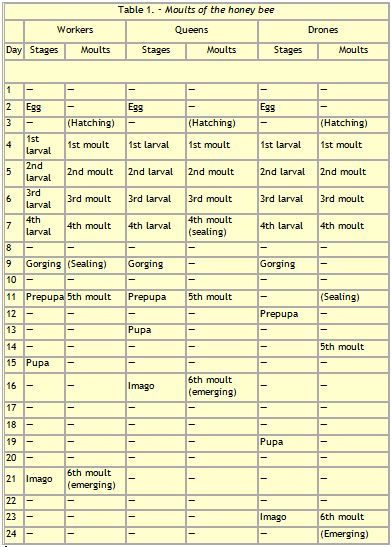Honey Bees Molt
During its development the larval honey bee sheds its skin five times. [Dadant & Sons, 70]
Figure 1. - Worker bee brood showing eggs and young larvae.
All castes of honey bees molt about every 24 hours during the first 4 days of larval life. When the ecdysis or molting occurs, the skin splits over the head and slips off the posterior end of the larva. This process normally takes less than 30 minutes. Each new larval stage (instar) is at first only slightly larger than the previous one, but it grows rapidly. The fifth larval instar gains about 40 percent of the total mature larval weight during days 8 and 9 (table 1).
By the end of the 8th day after the egg was laid, the cell containing the worker larva is capped. During the 9th day, the larva spins a cocoon using silk from a special gland in its head. On the 10th day, the larva stretches out on its back with its head toward the cell opening and becomes quiescent inside its cocoon. This stage usually is called the prepupa. The 5th molt, which occurs during the 11th day, reveals the pupal form-white in color and motionless (fig. 2). Color develops gradually, first in the eyes (13th day), then in the abdomen (15th day), legs (16th day), wings (18th day), and finally in the antennae (20th day).
Figure 2. - Successive stages of development from egg to mature larva. Enlarged slightly.
Throughout this period, the pupa is encased in a thin outer skin which is shed in the 6th and final molt on the 20th day. Thus, legs, wings, and mouth parts are freed and the pupa becomes an imago (adult) which soon begins to chew its way out of the cell (fig. 3).
Figure 3. - From mature larva to adult bee. About natural size.
[Waller, BeeSource.com]
Citations:
Dadant & Sons. The Hive and the Honey Bee: A New Book on Beekeeping Which Continues the Tradition of "Langstroth on the Hive and the Honeybee" Revision 7 ed. Hamilton, Ill.: Dadant, 1984. Print.
Waller, Gordon D. Honey Bee Life History. Beesource.com http://www.beesource.com/resources/usda/honey-bee-life-history/. BEEKEEPING IN THE UNITED STATES. Agriculture Handbook Number 335. 1980. Pages 24-29



